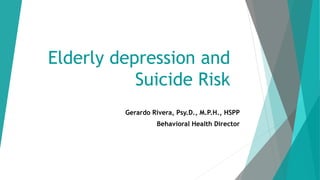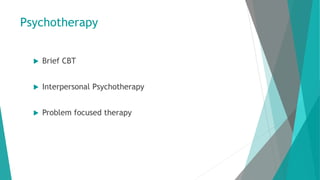Elderly Depression and Suicide Risk
- 1. Elderly depression and Suicide Risk Gerardo Rivera, Psy.D., M.P.H., HSPP Behavioral Health Director
- 2. Objective Being able to identify elderly patients with depression and classify it’s severity. Be able to identify special characteristics of depression in the elderly population. Suicide Risk Identify level of care needed and treatment needed. Be able to choose basic treatment considering signs, symptoms and comorbid conditions.
- 3. Depression
- 4. Depression and Public Health Leading cause of both injury and disease for people around the world. By 2020 second most common disability following heart disease. Estimated burden of $200 billion. Biggest challenge to depression is providing access to care. Depression affects an estimated one in 15 adults (6.7%) in any given year.
- 6. Suicide
- 7. Sociodemographic Male Female Total Year Frequency % Frequency % 2014 216 81.5 49 18.5 265 2015 220 88.0 30 12.0 250 2016 186 88.2 25 11.8 211 2017 223 85.8 37 14.2 260 2018 211 86.8 32 13.2 243 2019 74 87.1 11 12.9 85 http://www.salud.gov.pr/Estadisticas-Registros-y-Publicaciones/Estadisticas%20Suicidio/Mayo%202019.pdf
- 8. Elderly Suicide Statistics 2014 2015 2016 2017 2018 2019 65 + 61 23% 57 23% 49 23% 83 32% 61 25% 21 25%
- 9. Depressive Disorder Depressive Disorder Not Otherwise Specified Major Depressive Disorder Dysthymia Premenstrual Dysphoric Disorder Adjustment Disorder Depressive Disorder due to general medical condition Depressive Disorder due to substance Bipolar Disorder Schizoaffective Disorder
- 10. DSM V Criteria Major Depressive Disorder Symptoms must last at least two weeks for a diagnosis of depression. Feeling sad or having a depressed mood Loss of interest or pleasure in activities once enjoyed Changes in appetite — weight loss or gain unrelated to dieting Trouble sleeping or sleeping too much Loss of energy or increased fatigue Increase in purposeless physical activity (e.g., hand-wringing or pacing) or slowed movements and speech (actions observable by others) Feeling worthless or guilty Difficulty thinking, concentrating or making decisions Thoughts of death or suicide
- 11. IMPORTANT Rule/Out Medical Causes Contributing or Causing Depressive Disorder!!!!
- 12. Severity Mild Feeling sad Changes in appetite Loss of energy Moderate Trouble sleeping Loss of interest or pleasure in activities once enjoyed Difficulty concentrating Severe Thought of death or suicide Feelings of worthlessness or guilty
- 13. Elderly population in P.R.: some facts.. An aged society is considered when 10% or more of its population is 65 years or older. 2017 = 19.7% Puerto Ricans 65 or older (n= 658,755) 56.8% women 39.2% living alone 48.8% with some disability
- 14. Elderly population in P.R.: some facts.. Top Five Death Causes (2017): 1. Cardiovascular disease 2. Cancer 3. Diabetes 4. Alzheimer related 5. Cerebrovascular disease
- 15. Late life depression prevalence Depression occurs in late life, but is not a normal part of aging. On average, 1-3% of the 65+ population suffers from a Major depressive Disorder (MDD). More common in women 6-12 month course
- 16. Associated risk factors to late-life depression Chronic illness (CVA, DM, HTN, CA, Alz) Cognitive impairment Functional impairment Hx of depression SUD (Alcohol, Rx) Altered sleep patterns Lack of social support Personality traits Stressful life events Bereavement Widowed / divorced Socioeconomic disadvantage Caregiver of disabled/ill
- 17. Assessment: “Elderly depressed patients chief initial complaint is usually of Physical nature” Fatigue Weight loss Headache Insomnia GI discomfort Pain Multiple unexplained Sxs Memory complaints Social withdrawal Diminished appetite Diminished meds intake Diminished self-care Increased use of anxiolytic/tranquilizing meds Increased use of alcohol
- 18. Assessment: Suggested guidelines Administer screening tools: PHQ-9 and GDS (Geriatric Depression Scale) Review DSM V diagnosis criteria Physical examination Determine severity Assess suicide risk always ID comorbid psychiatric/medical conditions Review current medications Assess current life stressors Assess ADLs / disability / cognitive status (MoCA) Evaluate social support
- 19. Screening Tools: PHQ-9 and GDS
- 20. Suicidal Ideation Present: What to Assess? Identify the nature of current suicidal ideation ( previous attempts, illness, pain, loss, etc..) Explore planning: Have you had thoughts on how you might hurt yourself? Probability: How sure you are on acting or following those thoughts of hurting yourself? Preventive factors: Is there anything that can be done to prevent you from doing or thinking of doing harm to yourself?
- 21. Management Mild Referral to collocated Moderate Referral to collocated Consider using psychotherapy and or psychopharmacology Partial Hospitalization referral Severe Inpatient hospitalization and/or Partial Hospitalization
- 22. Partial Hospitalization (Day Hospital) No suicidal or homicidal plans Moderate depressive symptoms Significant dysfunction in social, occupational or academic settings Mental status recently affected by a crisis (i.e loss of a loved one, unemployment, loss of housing)
- 23. Partial Hospitalization (Day Hospital) Usual treatment is between 3-5 days although extension can be requested Usual schedule 8am-2pm or 5pm-9pm Maximum of 7 days Patient receives around 5-7 therapy sessions Group or individual therapies At least 2 psychiatric evaluations Can be started in pharmacotherapy and/or optimize current medications regimen Family interventions Patient have the opportunity to practice techniques learned in the Day Hospital and returned next day for feedback
- 24. Psychopharmacology What to do before prescribing a psychiatric medication?
- 27. Antidepressants SSRI Escitalopram Fluoxetine Paroxetine Sertraline
- 28. Antidepressants SNRI Venlafaxine Duloxetine
- 29. Antidepressants Atypical Mirtazapine Bupropion
- 30. Psychotherapy Brief CBT Interpersonal Psychotherapy Problem focused therapy
- 31. Post Test Juan acude a su médico primario con quejas de no poder dormir, sentirse triste y ansioso por situación familiar. Estos síntomas llevan 1 semana de evolución. Juan niega ideas suicidas y homicidas. A su vez niega síntomas psicóticos. Cuál es la intervención más adecuada para con Juan? A. Iniciarlo en antidepresivo B. Referirlo a una hospitalización total C. Referirlo a una hospitalización parcial D. Referirlo al colocado para evaluación y sesión corta de terapia Respuesta: D. Referirlo al colocado para evaluación y sesión corta de terapia
- 32. Myrna es una paciente con asma la cual acude al su médico primario con quejas de depresión con tristeza, minusvalía, desesperanza, problemas de sueño y ha contemplado que sería de su familia si ella no estuviese viva. Cuál es la mejor intervención con Myrna? A. Referirla a hospitalización total B. Iniciar tratamiento farmacológico C. Referirla a hospitalización parcial D. Referirla al colocado Post Test Respuesta: C. Referirla a hospitalización parcial
- 33. Reference http://www.salud.gov.pr/Estadisticas-Registros-y- Publicaciones/Estadisticas%20Suicidio/Febrero%202019.pdf https://www.psychiatry.org/ https://www.uptodate.com/contents/search?search=depression DSM V Blackburn, P., Wiese, B., Wilkins, M. Depression in Older Adults: Diagnosis and Management. British Columbia Medical Journal 2017; 59(3): 171-177 KoK, R.M., Reynolds, C.F. Management of Depression in Older Adults: A review. JAMA; 2017;317(20): 2114-2122 Knight, B.G & Qualls, S.H. Psychotherapy for Depression in Older Adults. Wiley (2006) SAMHSA: Older Americans Behavioral Health. Issue Brief 4: Preventing Suicide in Older Adults
- 34. Preguntas
Editor's Notes
- Hypothirodism….cuanto tarda y si se medica o no Cancer Vitamin Deficiency RA Medications Cancer medications Endocrine medications Pain medications
- Age Metabolic function Medicatios beign used Symptoms wish to diminished Side effects to the patient Informed consent


































